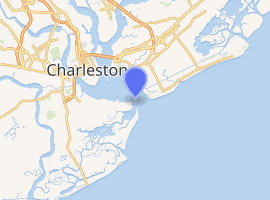Fort Sumter Range Lights
The Fort Sumter Range Lights are range lights to guide ships through the main channel of the Charleston Harbor, South Carolina. The original front light was built at Fort Sumter and the original rear light was in the steeple of St. Philip's Church in Charleston, South Carolina.[1][2] Both lights were lit from 1893 to 1915 to make range lights.[1] Today the Fort Sumter Range is the main approach channel to Charleston Harbor.[3]
.jpg) The lighthouse on Fort Sumter | |

| |
| Location | Charleston Harbor |
|---|---|
| Coordinates | 32°45′8″N 79°52′29″W (Fort Sumter) 32°46′45″N 79°55′45″W (St. Philips) |
| Year first constructed | 1855 (Fort Sumter) 1893 (St. Philip's) |
| Automated | 1950 (Fort Sumter) |
| Deactivated | 1915 (St. Philip's) early 1950s (Fort Sumter) |
| Tower shape | Hexagonal tower (Fort Sumter) Skeletal tower (Fort Sumter after 1893) Pyramidal church steeple (St. Philip's) |
| Tower height | 51 feet (16 m) (Fort Sumter) 140 feet (43 m) (St. Philip's) |
| Original lens | 5th order Fresnel lens (Fort Sumter) White lantern (St. Philip's) |
| Fog signal | Bell (Fort Sumter) |
| ARLHS number | 299 1163 USA-1163 |
Fort Sumter, which was the site of the first battle of the Civil War,[4] is now a National Monument. St. Philip's is a National Historic Landmark that was built in 1836.[5][6]
History
The front light at Fort Sumter completed in 1857.[7] The front light was a white, fifth order Fresnel lens.[2] The station was destroyed during the Civil War. A temporary light with a steamer lens was in place after the war ended and Fort Sumter was reoccupied by federal troops.[8] Later the light was rebuilt. With little chance of war, this lighthouse was the major activity at Fort Sumter from 1876 to 1898.[9]
In 1893, the front light was destroyed by a hurricane. The tower was replaced with a light green metal skeletal tower. The fog signal was a bell mechanically struck with a double blow every 15 s. After the rear light was extinguished in 1915, a radio beacon was added. The radio beacon was moved to Sullivan's Island lifesaving station in 1950. The light was deactivated in the early 1950s.[1][2]
.jpg)
The rear range light was a white lantern in the steeple of St. Philip's Church in Charleston that was lit in 1893.[1] The height of the lantern was 140 feet (43 m). The Annual Report of the Light-House Board reported that the electric apparatus for lighting the gas burner in the locomotive headlight was repaired in 1901.[10] This light was removed in 1915.[1][2]
Today
The Fort Sumter Range is currently the main approach channel to the Charleston Harbor.[11][12][13] Its front light is near Fort Sumter and its rear light is a lighted tower near the site of the old Fort Ripley Shoal Light.[3][11][13]
References
- Clary, Margie Willis, The Beacons of South Carolina, Sandlapper Publishing Co., Inc., Orangeburg, SC, 2005, pp. 107-108, ISBN 0-87844-176-X.
- "Historic Light Station Information and Photography: South Carolina". United States Coast Guard Historian's Office. Archived from the original on 2017-05-01. Retrieved 2008-08-10.
- Light List, Volume III, Atlantic Coast, Little River, South Carolina to Econfina River, Florida (PDF). Light List. United States Coast Guard. 2007. p. {{{page}}}.
- "Fort Sumter National Monument". US National Park Service. Retrieved 2008-08-10.
- "St. Philip's Episcopal Church (Charleston)". National Historic Landmarks Program. US National Park Service. Archived from the original on 2011-06-06. Retrieved 2008-08-10.
- Putnam, George R., Lighthouses and Lightships of the United States, Houghton Mifflin Company, Boston, MA, 1917, pp. 99, ISBN 0-87844-176-X.
- U.S. Senate, Executive Documents of the Senate of the United States: Third Session Thirty-Fourth Congress, A.O.P. Nicholson, Printer, Washington, DC, 1857, p. 600.
- Secretary of the Treasury, Report of the Secretary of the Treasury for the Year 1865, Government Printing Office, Washington, DC, 1865, p. 196.
- Barnes, Frank , Fort Sumter National Monument, South Carolina, National Park Service. Historical handbook series, no. 12, Washington, DC, 1962.
- U.S. Light-House Board, Annual Report of the Light-House Board Fiscal Year ending June 30, 1901., Government Printing Office, Washington, DC, 1901, p. 123.
- NOAA. "Chart 11521: Charleston Harbor and Approaches". Office of Coast Survey, Silver Spring, MD. Retrieved 2008-08-13.
- NOAA. "Chart 11523: Charleston Harbor Entrance". Office of Coast Survey, Silver Spring, MD. Retrieved 2008-08-13.
- NOAA. "Chart 11524: Charleston Harbor". Office of Coast Survey, Silver Spring, MD. Retrieved 2008-08-13.
